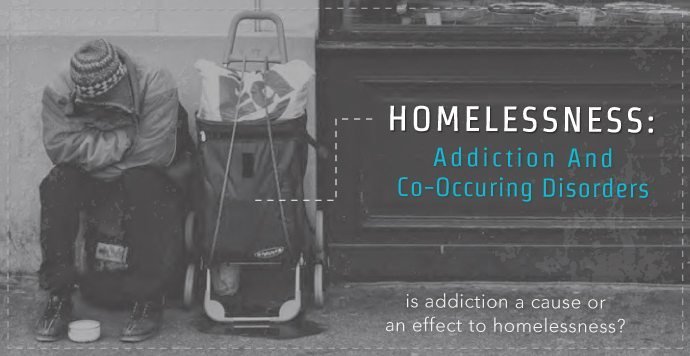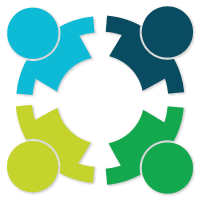Homelessness: Addiction And Co-Occuring Disorders

Addiction is at the forefront of troubles in our country. So much so, public school systems, police departments, doctors, court officials, and other profit and nonprofit organizations are beginning to work together to form community groups to bring attention and support to homelessness of those with substance use/abuse issues. It has been reported that alcohol abuse is more common in older adults and drug abuse is more common in homeless youth and young adults.
 SAMHSA’s (Substance Abuse and Mental Health Services Administration) national drug survey from 2013 reported that 7.9 million people in the United States alone struggled with co-occurring disorders. Co-occurring disorders, also known as “dual diagnoses,” is defined by those having both a mental illness along with a substance use or addiction issue. A lot of times, when identified as having a co-occurring disorder, some symptoms or issues are left untreated due to the multifaceted nature of co-occurring disorders.
SAMHSA’s (Substance Abuse and Mental Health Services Administration) national drug survey from 2013 reported that 7.9 million people in the United States alone struggled with co-occurring disorders. Co-occurring disorders, also known as “dual diagnoses,” is defined by those having both a mental illness along with a substance use or addiction issue. A lot of times, when identified as having a co-occurring disorder, some symptoms or issues are left untreated due to the multifaceted nature of co-occurring disorders.
Most behavioral health professionals treat either the mental health issue or the addiction, but rarely both. Proper treatment for a co-occurring disorder consists of integrated care; the treatment of both the mental illness and the substance use issue simultaneously.
There is a stigma in our culture that the majority of people experiencing homelessness are addicted to alcohol and/or drugs. In reality, it is hard to determine whether addiction is a cause or an effect to homelessness. SAMHSA has reported in 2003 that only 38 percent of people experiencing homelessness were dependent on alcohol and 26 percent were dependent on other drugs. In fact, people experiencing homelessness often start using drugs and/or alcohol to cope with their mental illness and/or negative living situation.
It is important to point out that in individuals who are not homeless, the use of drugs and/or alcohol increases when they are suffering from a mental illness. This sometimes results in loss of jobs, relationships, and housing, causing them to become homeless.
Introducing
virtual care
Get treatment when
and how you need it.
Homelessness becomes an act of survival and not stabilization in all realms of life including work, housing, money management, healthcare, and skills development. Finding food and shelter daily becomes more important than treatment for a mental illness and/or addiction. So is addiction the cause or effect of homelessness? Addiction is both a cause and an effect to homelessness, but it is important to point out that it is not the cause in the majority of people experiencing homelessness.
Treatment Planning
 Harm reduction has proven to be the best form of treatment when working with a client experiencing homelessness, rather than suggesting they completely refrain from using – whether it is alcohol or another form of drug (prescribed or unprescribed medication, street drugs, etc). Harm reduction is defined as the reduction of the substance (alcohol or drugs) over time, rather than expecting the elimination of the substance immediately.
Harm reduction has proven to be the best form of treatment when working with a client experiencing homelessness, rather than suggesting they completely refrain from using – whether it is alcohol or another form of drug (prescribed or unprescribed medication, street drugs, etc). Harm reduction is defined as the reduction of the substance (alcohol or drugs) over time, rather than expecting the elimination of the substance immediately.
You may have seen in recent years “wet houses” becoming increasingly popular. Wet houses are places where an individual may live (usually those who are homeless) to get off the streets; during their stay they are allowed to drink. The drinking is monitored by staff, the goal being to assist them in decreasing their alcohol usage until they are stable.
“Research on change and the many years of experience have shown that most people change gradually and experience ups and downs along the way” -The Center For Harm Reduction Therapy
When treating a co-occurring disorder, especially with those experiencing homelessness, the treatment plan should remain person-centered, which is described from medical dictionaries as: “a term that reflects the individual’s unique preferences, values and needs, identified and agreed upon in partnership with the treating professional.” It is important that the goals or treatment plan are agreed upon or chosen by the client and agreed upon by the professional, as well.
It is also important to remember that each client is different and has a different motivation to continue using. When a client is able to choose their own goals instead of being told what to do based on the professional’s opinion, they feel empowered to succeed and accomplish these goals resulting in an overall successful outcome. Without an acceptable treatment plan, the client’s success rate of recovery decreases.
Annette Goodyear, MA, LPC, NCC
I have worked for a nonprofit for almost nine years. I’ve assisted with people experiencing homelessness, forming person-centered treatment plans and chairing the integrated care system for the community. What I have found is that there is a greater rate of success with people experiencing homelessness when the homeless response system of care is working together to provide an integrated system of treatment. It is important for the success of the client with goals, treatment planning, and overall quality of life that both the mental illness and the substance use issue are treated simultaneously. It has been proven all over our nation that with this kind of person-centered and integrated care, an overall decrease in community cost has resulted, including the number of times a person experiencing homelessness uses emergency care, and also in illegal activity committed resulting in an arrest.




